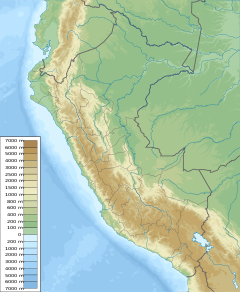| Phrynopus bracki | |
|---|---|
| Conservation status | |
 Data Deficient (IUCN 3.1) | |
| Scientific classification | |
| Domain: | Eukaryota |
| Kingdom: | Animalia |
| Phylum: | Chordata |
| Class: | Amphibia |
| Order: | Anura |
| Family: | Strabomantidae |
| Genus: | Phrynopus |
| Species: | P. bracki |
| Binomial name | |
| Phrynopus bracki Hedges, 1990 | |
Phrynopus bracki is a species of frog in the family Strabomantidae. It is endemic to Peru and only known from its type locality in the Cordillera Yanachaga, Pasco Region. The specific name bracki honors Antonio Brack, agronomist and ecologist who was instrumental for the establishment of the Yanachaga–Chemillén National Park. Common name Brack's Andes frog, has been coined for it.
Description
Based on the type series consisting of two adult males and a single female, adult males measure about 15.7–16.2 mm (0.62–0.64 in) and adult females 19.8 mm (0.78 in) in snout–vent length. The head is short and narrower than the body. The snout is rounded to slightly truncate. The canthus rostralis is moderately sharp. There is no tympanum, and also the supra-tympanic fold is absent. The fingers and toes are not expanded; the fingers have slight lateral fringes. No webbing is present. Skin of the dorsum is tuberculate, more so in the males than in the female. The coloration is nearly uniformly black or very dark brown, apart from some faint traces of lighter brown pattern.
The male advertisement call is a two-note call, with the dominant frequency at 2500 Hz.

Habitat and conservation
Phrynopus bracki is found in montane cloud and elfin forest at elevations of 2,300–2,700 m (7,500–8,900 ft) above sea level. It is a terrestrial species. The males were found inside curled dead leaves on the forest floor, revealed by their calls, whereas the female was found in leaf litter.
This species is threatened by habitat loss, but most of its range is protected by the Yanachaga–Chemillén National Park.
References
- ^ IUCN SSC Amphibian Specialist Group (2018). "Phrynopus bracki". IUCN Red List of Threatened Species. 2018: e.T57202A89210514. doi:10.2305/IUCN.UK.2018-1.RLTS.T57202A89210514.en. Retrieved 15 November 2021.
- ^ Hedges, S. Blair (1990). "A new species of Phrynopus (Anura: Leptodactylidae) from Perú". Copeia. 1990 (1): 108–112. doi:10.2307/1445826. JSTOR 1445826. S2CID 88116881.
- ^ Frost, Darrel R. (2022). "Phrynopus bracki Hedges, 1990". Amphibian Species of the World: An Online Reference. Version 6.1. American Museum of Natural History. Retrieved 16 October 2022.
- Beolens, Bo; Watkins, Michael & Grayson, Michael (2013). The Eponym Dictionary of Amphibians. Pelagic Publishing. p. 29. ISBN 978-1-907807-42-8.
| Taxon identifiers | |
|---|---|
| Phrynopus bracki | |